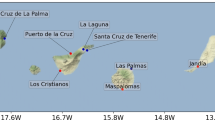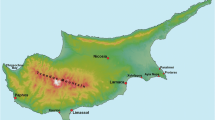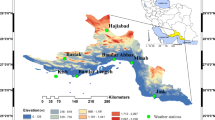Abstract
Climate and weather patterns are an essential resource for outdoor tourism activities. The projected changes in climate and weather patterns are expected to affect the future state of tourism. The present study aims to quantify the positive or negative effect of a 2 °C global warming on summertime climate comfort in the sense of exercising activities that involve light body activity. The well-established Climate Index for Tourism (CIT) and three variants of the widely used Tourism Climatic Index (TCI) were analyzed. Additionally, a new index based on TCI and CIT was tested and compared against the precious indices. Past and future climate data of five high-resolution regional climate models (RCMs) from different Representative Concentration Pathways (RCP4.5 and RCP8.5) of the European Coordinated Regional Climate Downscaling Experiment (Euro-CORDEX) for a +2 °C period were used. The results indicate improvement in the climate comfort for the majority of European areas for the May to October period. For the June to August period, central and northern European areas are projected to improve, while marginal improvement is found for Mediterranean countries. Furthermore, in specific cases of adjacent Mediterranean areas such as the southern Iberian Peninsula, the June to August climate favorability is projected to reduce as a result of the increase to daytime temperature. The use of a set of different indices and different RCMs and RCPs samples a large fraction of the uncertainty that is crucial for providing robust regional impact information due to climate change. The analysis revealed the similarities and the differences in the magnitude of change across the different indices. Moreover, discrepancies were found in the results of different concentration pathways to the +2 °C global warming, with the RCP8.5 projecting more significant changes for some of the analyzed indices. The estimation of the TCI using different timescale climate data did not change the results on tourism significantly.





Similar content being viewed by others
References
Ainsworth BE, Haskell WL, Whitt MC, et al. (2000) Compendium of physical activities: an update of activity codes and MET intensities. Med Sci Sports Exerc 32:S498–S504
Amelung B, Moreno A (2009) Impacts of climate change in tourism in Europe. PESETA-Tourism study - Publication - IPTS Web Site.
Amelung B, Nicholls S (2014) Implications of climate change for tourism in Australia. Tour Manag 41:228–244. doi:10.1016/j.tourman.2013.10.002
Amelung B, Nicholls S, Viner D (2007) Implications of global climate change for tourism flows and seasonality. J Travel Res 45:285–296. doi:10.1177/0047287506295937
Amelung B, Viner D (2006) Mediterranean tourism: exploring the future with the Tourism Climatic Index.
Bafaluy D, Amengual A, Romero R, Homar V (2013) Present and future climate resources for various types of tourism in the Bay of Palma, Spain. Reg Environ Chang 14:1995–2006. doi:10.1007/s10113-013-0450-6
Betts RA, Collins M, Hemming DL, et al. (2010) When could global warming reach 4 C? Philos Trans R Soc A Math Phys Eng Sci 369:67–84. doi:10.1098/rsta.2010.0292
Blazejczyk K, Epstein Y, Jendritzky G, et al. (2012) Comparison of UTCI to selected thermal indices. Int J Biometeorol 56:515–535. doi:10.1007/s00484-011-0453-2
Bröde P, Fiala D, Błażejczyk K, et al. (2012) Deriving the operational procedure for the Universal Thermal Climate Index (UTCI). Int J Biometeorol 56:481–494. doi:10.1007/s00484-011-0454-1
Broede P, Jendritzky G, Fiala D, Havenith G (2010) The Universal Thermal Climate Index UTCI in operational use
Crowe RB (1976) A climatic classification of the Northwest Territories for recreation and tourism. Environment Canada, Toronto, Canada
de Freitas CR (2003) Tourism climatology: evaluating environmental information for decision making and business planning in the recreation and tourism sector. Int J Biometeorol 48:45–54. doi:10.1007/s00484-003-0177-z
de Freitas C, Scott D, Gössling S (2008) Preferred climates for tourism: case studies from Canada, New Zealand and Sweden. Clim Res 38:61–73
Deque M (2007) Frequency of precipitation and temperature extremes over France in an anthropogenic scenario: model results and statistical correction according to observed values. Glob Planet Change 57:16–26. doi:10.1016/j.gloplacha.2006.11.030
Eurobarometer (2012) Flash Eurobarometer 334: attitudes of Europeans towards tourism. Datasets
Fanger PO (1970) Thermal comfort: analysis and applications in environmental engineering. McGraw-Hill.
G8 L’Aquila Declaration (2009) G8 and newly industrializing countries agree on 2-degree target for the first time
Goh C (2012) Exploring impact of climate on tourism demand. Ann Tour Res 39:1859–1883. doi:10.1016/j.annals.2012.05.027
Hamilton J.M., MA. Lau (2005) The role of climate information in tourist destination choice decision-making.
Hamilton JM (2004) Climate and the destination choice of German tourists. SSRN Electron J. doi:10.2139/ssrn.504362
Haylock MR, Hofstra N, Klein Tank AMG, et al. (2008) A European daily high-resolution gridded data set of surface temperature and precipitation for 1950–2006. J Geophys Res 113:D20119. doi:10.1029/2008JD010201
Hounam CE (1967) Meteorological factors affecting physical comfort (with special reference to Alice Springs, Australia). Int J Biometeorol 11:151–162. doi:10.1007/BF01426842
Kandror I, Demina D, Ratner Y (1974) Fiziologicheskye prin-cipy sanitarno—klimatologicheskogo rayonirovanya terri-toriè SSSR.
Lise W, Tol RSJ (2002) Impact of climate on tourist demand. Clim Change 55:429–449. doi:10.1023/A:1020728021446
Maddison D (2001) In search of warmer climates? The impact of climate change on flows of British tourists. Clim Change 49:193–208. doi:10.1023/A:1010742511380
Maraun D, Wetterhall F, Ireson AM, et al. (2010) Precipitation downscaling under climate change: recent developments to bridge the gap between dynamical models and the end user. Rev. Geophys 48:RG3003. doi:10.1029/2009RG000314
Matzarakis A (2007) Assessment method for climate and tourism based on daily data.
Matzarakis A (2006) Weather- and climate-related information for tourism. Tour Hosp Plan Dev 3:99–115. doi:10.1080/14790530600938279
Matzarakis A, de Freitas C (2001) Proceedings of the first international workshop on climate, tourism and recreation.
Matzarakis A, Mayer H (1996) Another kind of environmental stress: thermal stress. WHO Newsl. 18:7–10
Méndez-Lázaro PA, Terrasa-Soler JJ, Torres-Peña C, et al. (2014) Tourism and climate conditions in San Juan, Puerto Rico, 2000–2010. Ecol Soc 19:11
Mieczkowski Z (1985) The Tourism Climatic Index: a method of evaluating world climates for tourism. Can Geogr Géographe Can 29:220–233. doi:10.1111/j.1541-0064.1985.tb00365.x
Missenard FA (1933) Température effective d’une atmosphere Généralisation température résultante d’un milieu. In: Encyclopédie Industrielle et Commerciale, Etude physiologique et technique de la ventilation.
Morgan R, Gatell E, Junyent R, et al. (2000) An improved user-based beach climate index. J Coast Conserv 6:41–50. doi:10.1007/BF02730466
Perch-Nielsen S, Amelung B, Knutti R (2010) Future climate resources for tourism in Europe based on the daily Tourism Climatic Index. Clim Change 103:363–381. doi:10.1007/s10584-009-9772-2
Perch-Nielsen SL (2009) The vulnerability of beach tourism to climate change—an index approach. Clim Change 100:579–606. doi:10.1007/s10584-009-9692-1
Perry A (1997) Recreation and tourism. In: Thompson RD, Perry AH (eds) Applied climatology. Routledge, London, pp. 240–248
Rusu S (2011) Tourism multiplier effect. J. Econ. Bus. Res. 17:70–76
Rutty M, Scott D (2015) Bioclimatic comfort and the thermal perceptions and preferences of beach tourists. Int J Biometeorol 59:37–45. doi:10.1007/s00484-014-0820-x
Sanford T, Frumhoff PC, Luers A, Gulledge J (2014) The climate policy narrative for a dangerously warming world. Nat Clim Chang 4:164–166. doi:10.1038/nclimate2148
Scott D, McBoyle G (2001) Using a ‘tourism climate index’ to examine the implications of climate change for climate as a natural resource for tourism. In: Matzarakis A, de Freitas CR (eds) Proceedings of the First International Workshop on Climate, Tourism and Recreation, International Society of Biometeorology, Commission on Climate, Tourism and Recreation, Halkidi, Greece, pp 69–88
Scott, McBoyle G, Schwartzentruber M (2008) Climate change and the distribution of climatic resources for tourism in North America. Clim Res 27:105–117
Themeßl MJ, Gobiet A, Heinrich G (2011) Empirical-statistical downscaling and error correction of regional climate models and its impact on the climate change signal. Clim Change 112:449–468. doi:10.1007/s10584-011-0224-4
UNWTO (2014) Working together in Europe—a shared leadership. Madrid.
UNWTO (2013) Tourism highlights, 2013 edition.
Vautard R, Gobiet A, Sobolowski S, et al. (2014) The European climate under a 2 °C global warming. Environ Res Lett 9:034006. doi:10.1088/1748-9326/9/3/034006
Yan YY, Oliver JE (1996) The clo: a utilitarian unit to measure weather/climate comfort. Int J Climatol 16:1045–1056. doi:10.1002/(SICI)1097-0088(199609)16:9<1045::AID-JOC73>3.0.CO;2-O
Acknowledgments
The research received funding from the IMPACT2C project of the European Union Seventh Framework Programme 2007–2013 under grant agreement no. 282746. We acknowledge the World Climate Research Programme’s Working Group on Regional Climate and the Working Group on Coupled Modelling, former coordinating body of CORDEX and responsible panel for CMIP5. We also thank the climate modeling groups (listed in Table S4 of the Electronic Supplementary material) for producing and making available their model output. We also acknowledge the Earth System Grid Federation infrastructure, an international effort led by the U.S. Department of Energy’s Program for Climate Model Diagnosis and Intercomparison; the European Network for Earth System Modelling; and other partners in the Global Organization for Earth System Science Portals (GO-ESSP).
Author information
Authors and Affiliations
Corresponding author
Electronic supplementary material
ESM 1
(DOCX 12.2 mb)
Rights and permissions
About this article
Cite this article
Grillakis, M.G., Koutroulis, A.G. & Tsanis, I.K. The 2 °C global warming effect on summer European tourism through different indices. Int J Biometeorol 60, 1205–1215 (2016). https://doi.org/10.1007/s00484-015-1115-6
Received:
Revised:
Accepted:
Published:
Issue Date:
DOI: https://doi.org/10.1007/s00484-015-1115-6




